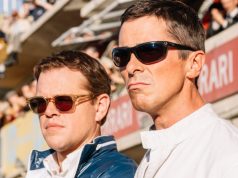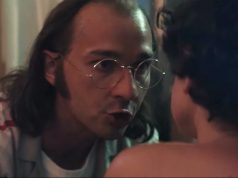Nothing about “The Artist” is transcendent or brilliant. A frothy, upbeat tale of old Hollywood, it’s clever but not particularly innovative, different but not unique, funny but not hilarious. Yet as frothy, upbeat tales of old Hollywood go, it’s superb, full of small delights and general sunshine.
The year is 1927, and a grinning ham named George Valentin (Jean Dujardin) is silent cinema’s brightest star, his dashing good looks and pencil-thin mustache gracing the screen in action-romance-adventures like “A Russian Affair” and, coming soon, “A German Affair.” With a talented Jack Russell terrier as his sidekick both onscreen and off, George lives a life of constant shtick: mugging for cameras, absorbing applause, doing comedy bits at the breakfast table for his unamused wife (Penelope Ann Miller). Though he can be an oblivious buffoon — especially toward his put-upon costar (Missi Pyle) — there’s something innocent about his exuberance, like he himself can barely believe how famous and lucky he is. He’s on top of the world, in that comically exaggerated way that characters are on top of the world right before something bad happens to them.
Along comes Peppy Miller (Berenice Bejo), a plucky gal with dreams of being a star. She uses a chance encounter with George to moxie her way onto the set of his next film as an extra, then parlays that into a film career. She flirts with George; George remains respectable, considering he is a married man. But there’s something there.
When the movies become talkies, Peppy readily adapts. George, however, is old-school. He protests that the audience never needed to hear him talk before, and that it’s silly to make such a drastic change when things are fine the way they are. The studio head (John Goodman), now in the business of making sound pictures exclusively, reluctantly lets George go. Undeterred, George sets out to write, produce, direct, and star in his own movie, a silent adventure like his fans are used to. But the public is fickle, and yesterday’s most famous man in the world is tomorrow’s has-been. The 1929 stock market crash doesn’t help George’s situation either. Only Clifton (James Cromwell), his faithful valet, stays by his side.
There’s a lovely scene in which George and Peppy run into each other on the studio lot as she’s going up the stairs and he’s coming down (a not-too-subtle metaphor for their career trajectories). They haven’t crossed paths in a while, and both of their fortunes have changed significantly. Whereas George was once perpetually happy, with no reason to doubt that his life would always be wonderful, he’s now drifting into unfamiliar territory: sadness. Peppy reminds him of a bright spot at what he now fears was the tail end of his career.
But like the corny melodramas it imitates, “The Artist” never gets bogged down in actual sadness. That would defeat the purpose, which is to revel in the simple charms of old Hollywood. Written and directed by Michel Hazanavicius, the whimsical Frenchman (is there any other kind?) who made the “OSS 117” spy spoofs a few years ago, “The Artist” pays homage to an era that the vast majority of moviegoers are too young to remember. Like the films of the 1920s, it’s in black-and-white and almost entirely silent, the dialogue conveyed with title cards, the action supported by Ludovic Bource’s thoroughly enjoyable musical score. (I don’t download a lot of instrumental movie soundtracks, but I’m listening to this one right now.)
Making a silent film in 2011, even a silent film about silent films, is a gimmick, sure, but Hazanavicius doesn’t use it as a joke. A joke would wear thin. “The Artist” remains jaunty and surprising all the way up to its of-course-there’s-a-happy-ending happy ending. Dujardin, with an expressive face made for silent movies and a gift for physical humor, captures that exaggerated, old-timey style of acting without parodying it, and Bejo (who is the director’s wife) is just as capable. The film executes its singular vision confidently, with no major missteps. It’s fun, all right? It’s just fun.
B+ (1 hr., 40 min.; )





